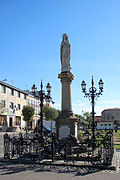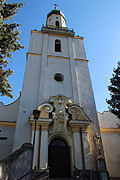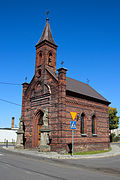Baborów
Baborów | |
|---|---|
 Saint Joseph Church | |
 Coat of arms | |
 Baborów | |
| Coordinates: 50°9′28″N 17°58′48″E / 50.15778°N 17.98000°ECoordinates: 50°9′28″N 17°58′48″E / 50.15778°N 17.98000°E | |
| Country | |
| Voivodeship | Opole |
| County | Głubczyce |
| Gmina | Baborów |
| Government | |
| • Mayor | Elżbieta Kielska |
| Area | |
| • Total | 11.73 km2 (4.53 sq mi) |
| Population (2019-06-30[1]) | |
| • Total | 2,905 |
| • Density | 250/km2 (640/sq mi) |
| Time zone | UTC+1 (CET) |
| • Summer (DST) | UTC+2 (CEST) |
| Postal code | 48-120 |
| Car plates | OGL |
| Website | http://www.baborow.pl |
Baborów [baˈbɔruf] (German: Bauerwitz) is a small town in southern Poland near Głubczyce, in the Opole Voivodeship, Głubczyce County, Gmina Baborów.
History[]
The first mention of the town comes from 1296 in which a wójt Jarosław is mentioned. The town was most likely founded by a Bohemian magnate, Bavor (Babor). Later it was part of an independent duchy, Habsburg-ruled Bohemia, the Kingdom of Prussia and from 1871 and 1945 also Germany. After the defeat of Nazi Germany in World War II it became part of Poland. It was granted town rights before 1340, although deprived of them from 1575 to 1718.[2]
According to the German census of 1890, the town had a population of 2,707, of which 2,220 (82%) were Czechs.[3] It marked the 19th-century linguistic border between German, Polish, and Czech.[4]
During World War II, the town, then known as Bauerwitz, was the base for two working parties (E288 and E398) of British and Commonwealth prisoners of war, under the administration of the German Stalag VIII-B/344 POW camp at Łambinowice (then known as Lamsdorf).[5] In January 1945, as the Soviet armies resumed their offensive and advanced from the east, the prisoners were marched by the Germans westward in the so-called Long March or Death March. Many of them died from the bitter cold and exhaustion. The lucky ones got far enough to the west to be liberated by the allied armies after some four months of travelling on foot in appalling conditions.[6] The town's German population was interned in Łambinowice camp, and expelled.[citation needed]
Notable people[]
- (1946–2019), Polish geographer and politician, member of the Polish Sejm
Twin towns – sister cities[]
See twin towns of Gmina Baborów.
Gallery[]

St. Mary column

World War II memorial

Assumption of Mary Church

Sacred Heart Chapel
References[]
- ^ "Population. Size and structure and vital statistics in Poland by territorial division in 2019. As of 30th June". stat.gov.pl. Statistics Poland. 2019-10-15. Retrieved 2020-02-14.
- ^ Robert Krzysztofik, Lokacje miejskie na obszarze Polski. Dokumentacja geograficzno-historyczna, Katowice, 2007, p. 18-19 (in Polish)
- ^ "Deutsche Verwaltungsgeschichte Schlesien, Kreis Leobschuetz". treemagic.org. Retrieved 2021-01-19.
- ^ Weinhold, Karl (1887). Die Verbreitung und die Herkunft der Deutschen in Schlesien [The Spread and the Origin of Germans in Silesia] (in German). Stuttgart: J. Engelhorn. pp. 194.
- ^ "Working Parties". Stalag VIIIB 344 Lamsdorf. Archived from the original on 20 January 2021. Retrieved 19 March 2020.
- ^ "History". Stalag VIIIB 344 Lamsdorf. Retrieved 19 March 2020.
- Cities in Silesia
- Cities and towns in Opole Voivodeship
- Głubczyce County
- Głubczyce County geography stubs





